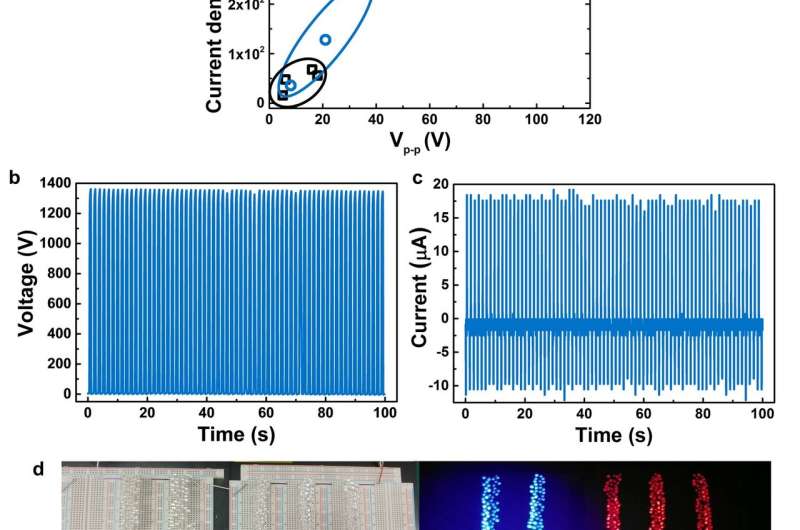Triboelectric performance of fluorinated polymeric sulfur (a) Phase diagram of voltage-current density outputs with carbon-based and sulfur-based polymers (b) Triboelectric voltage output of 4”-wafer scale fluorinated polymeric sulfur film after corona discharge treatment (c) Triboelectric current output of 4”-wafer scale fluorinated polymeric sulfur film after corona discharge treatment (d) Demonstration of direct powering of the 630 LEDs (~40 mW/ea.) through 4”-wafer scale fluorinated polymeric sulfur film after corona discharge treatment. Credit: Inha University
Triboelectric generation is an energy harvesting technique that generates electricity through induction of triboelectric effects using discarded physical energy. Materials employed to triboelectric generators (TEG) are classified positive or negative according to their value of electron affinity; negative materials generally employ fluorinated carbon-based polymers. Yet, most of the research for improving TEG performance focus mainly on structural improvements of device such as the multi-layer device structures, testing triboelectricity in a vacuum condition, and asymmetric device design rather than the development of novel polymeric materials.
Fluorinated carbon-based polymers (i.e. PTFE) are employed as highly negative triboelectric materials due to the high electron affinity of their halogens while carbon-backbones limit triboelectric performance due to low electron affinity of the carbon. Herein, we introduce, for the first time, fluorinated sulfur-based polymer as extremely negative triboelectric material for improvement of triboelectric performance. Sulfur can combine with fluorine more than carbon, up to two more, through an expanded octet using empty d orbital. It also has the highest electron affinity except halogens, gold and platinum. Hence, when sulfur is employed as the backbone element in triboelectric materials, higher triboelectric performance can be expected than from PTFE.
Sulfur-based polymers are thermoplastic-branched polymers and thus allow for facile thermal processability. Here, polymeric sulfur was formed to film and extremely negative fluorinated polymeric sulfur film was produced via surface fluorination. These yellow-chemistry based polymeric materials achieved 6-fold and 3-fold increase in triboelectric energy outputs in voltage and current in comparison with PTFE the current conventional negative material. Furthermore, the fluorinated polymeric sulfur film was fabricated in large scale (4 inch wafer scale) and was given corona discharge treatment to further enrich the surface negative charge. As a result, the fluorinated polymeric sulfur film achieved superior power outputs of 1366 V and 18 μA under the minimal force of ~ 30N.
The extremely negative triboelectric materials employed sulfur which is a by-product of petroleum refining that is generated in the surplus of 7 million tons annually. Thus the research not only presents a new option for triboelectric materials, but also a discovery of low cost and eco-friendly source for commercialization.
More information: Jong Hyeok Lee et al. Rational molecular design of polymeric materials toward efficient triboelectric energy harvesting, Nano Energy (2019). DOI: 10.1016/j.nanoen.2019.104158
Journal information: Nano Energy
Provided by Inha University
























